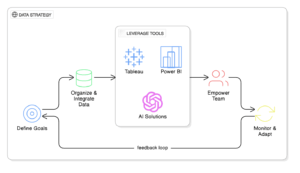
Businesses are producing enormous volumes of data at a never-before-seen pace. This data contains insightful information that can unlock better customer experiences and operational effectiveness, while guiding strategic decision-making.
However, sophisticated analytical methods and tools are needed to glean valuable insights from big data. Artificial intelligence (AI) and business analytics are crucial in this situation.
Analytics
Business analytics entails investigation, evaluation and interpretation of data. It includes prescriptive analytics, which offers suggestions to improve decision-making; predictive analytics, which forecasts future events using statistical modeling and machine learning; and descriptive analytics, which concentrates on summarizing historical data.
Businesses can make informed decisions and obtain a competitive edge by using business analytics to find patterns, trends and anomalies in their data.
Artificial Intelligence
AI is the simulation of human intelligence in machines that are capable of carrying out tasks that have historically required human cognitive abilities. AI systems are able to make predictions, identify patterns and automate difficult tasks because they learn from data and modify their behavior over time. A subset of artificial intelligence called machine learning algorithms allows computers to learn from front data without explicit programming, enabling them to make precise predictions and reveal previously undiscovered information.
The integration of business analytics and AI brings together the power of advanced analytics techniques and intelligent algorithms to leverage the potential of big data.
Successful Implementation Strategies
Strategic decision-making, organizational alignment and meticulous planning are necessary for the successful implementation of business analytics and AI projects.

- 1. Defining clear objectives and aligning analytics initiatives with business goals: Organizations must establish specific goals and make sure they are in line with their overall business objectives before launching into a business analytics and AI journey. This guarantees that analytics projects have clear goals and they directly support the strategic objectives of the company.
- 2. Establishing robust data infrastructure and governance frameworks: A strong foundation in data infrastructure and governance is necessary for the successful application of AI and business analytics. Businesses need to make investments in procedures and technology that facilitate the gathering, storing and integration of data and ultimately making it accessible to efficiently support analytics initiatives.
- 3. Cultivating a data-driven culture and fostering cross-functional collaboration: Organizations can offer education and training programs to improve data literacy among staff members at all levels in order to foster a data-driven culture. This promotes data-driven decision-making and helps create a common understanding of the importance of data. Furthermore, encouraging cross-functional cooperation between the analytics, IT and business teams facilitates the successful execution of analytics projects and encourages a comprehensive approach to problem-solving.
- 4. Investing in talent acquisition, training anal upskilling: The effective application of AI and business analytics depends on having a trained workforce. To build the requisite proficiency in analytics and AI technologies, organizations must fund talent acquisition, training and upskilling initiatives. Organizations can also use outside alliances, like joint ventures with universities or data science consulting companies, to fill skill shortages and gain access to specialized knowledge.
In conclusion, the integration of business analytics and artificial intelligence offers unprecedented opportunities for organizations to transform their operations, gain competitive advantage and drive innovation. By embracing these technologies, organizations can harness the power of data, make better-informed decisions and navigate the complexities of the digital era with confidence. Through careful implementation, they can position themselves at the forefront of a data-driven economy, leading the way towards a prosperous and intelligent future.

